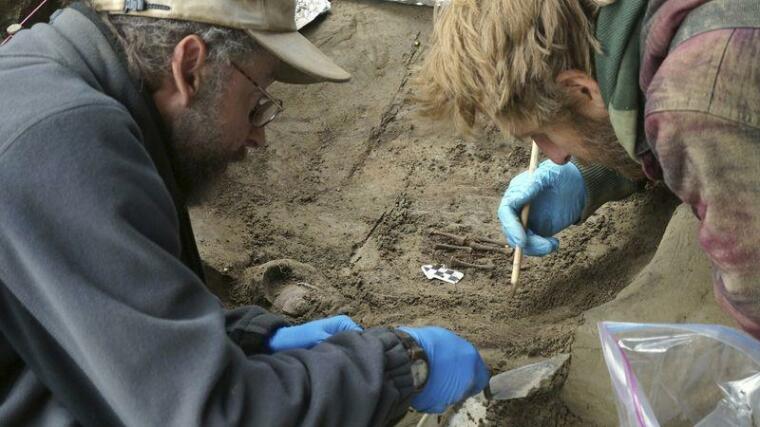Discovery of ancient DNA in Alaska supports Tower of Babel account, creationists say

Two Harvard-trained creationist researchers are claiming that the discovery of ancient human genetic material in Alaska corroborates the biblical account of human mass migration from the Tower of Babel.
According to a study published in the journal Nature on Jan. 3, genome extracted from the remains of an infant girl buried in central Alaska 11,500 years ago indicates that there has been a mass migration of people from East Asia, across a frozen land bridge, to North America.
A team of researchers, led by geneticist Eske Willerslev of the University of Copenhagen and the University of Cambridge in the United Kingdom, sequenced the infant's DNA and compared it to that of modern Native Americans as well as to other ancient and living people across Eurasia and the Americas.
The researchers noted that the infant's group was most closely related to modern Native Americans, but not a direct ancestor. The team believes that the infant's group and modern Native Americans shared common ancestry with people who crossed from Asia to North America through a land bridge called Beringia some 25,000 years ago.
Nathaniel Jeanson, a Harvard-trained research biologist with Answers in Genesis (AiG), believes that the dating of the infant girl's DNA was not accurate. However, he said that the other details of the discovery support the Genesis 11 account of mass human migration after the attempt to build the Tower of Babel.
He contended that the study is "more evidence for people in the Americas from Asia -- East Asia, Central Asia" and "is consistent with Scripture."
According to the biblical account, humans, who spoke a single language at the time, attempted to build "a tower with its top in the sky," but God intervened and caused them to begin speaking various languages and "scattered them throughout the earth."
Jeanson believes that the biblical chronology suggests that the event occurred more recently than the 11,500-year date assigned by the researchers. He disputed the evolutionary dating methods used by many secular scientists because he said that those methods are allegedly inconsistent with one another and based on unverified assumptions.
"Based on genetic clocks that have been published even by evolutionists, you can explain the origin of all people groups genetically within the last few thousand years," Jeanson told The Baptist Press.
Kurt Wise, a Southern Baptist and Harvard-trained paleontologist, suggested that the 11,500 "radiocarbon years" cited in the study "amount to many fewer true (chronological) years (probably closer to 4,000-4,100 years)."
Wise, a professor of natural history at Truett McConnell University, said that if the dates provided in the study are considered "in relative terms, the new findings are consistent with a dispersion of humans from Babel."
"So, these remains," Wise contended, "are most probably of a population of people spreading out from Babel."
 Christians don't have to affirm transgenderism, but they can’t express that view at work: tribunal
Christians don't have to affirm transgenderism, but they can’t express that view at work: tribunal Archaeology discovery: Medieval Christian prayer beads found on Holy Island
Archaeology discovery: Medieval Christian prayer beads found on Holy Island Presbyterian Church in America votes to leave National Association of Evangelicals
Presbyterian Church in America votes to leave National Association of Evangelicals Over 50 killed in 'vile and satanic' attack at Nigerian church on Pentecost Sunday
Over 50 killed in 'vile and satanic' attack at Nigerian church on Pentecost Sunday Ukrainian Orthodox Church severs ties with Moscow over Patriarch Kirill's support for Putin's war
Ukrainian Orthodox Church severs ties with Moscow over Patriarch Kirill's support for Putin's war Islamic State kills 20 Nigerian Christians as revenge for US airstrike
Islamic State kills 20 Nigerian Christians as revenge for US airstrike Man who served 33 years in prison for murder leads inmates to Christ
Man who served 33 years in prison for murder leads inmates to Christ


 Nigerian student beaten to death, body burned over ‘blasphemous’ WhatsApp message
Nigerian student beaten to death, body burned over ‘blasphemous’ WhatsApp message 'A new low': World reacts after Hong Kong arrests 90-year-old Cardinal Joseph Zen
'A new low': World reacts after Hong Kong arrests 90-year-old Cardinal Joseph Zen Iran sentences Christian man to 10 years in prison for hosting house church worship gathering
Iran sentences Christian man to 10 years in prison for hosting house church worship gathering French Guyana: Pastor shot dead, church set on fire after meeting delegation of Evangelicals
French Guyana: Pastor shot dead, church set on fire after meeting delegation of Evangelicals ‘Talking Jesus’ report finds only 6% of UK adults identify as practicing Christians
‘Talking Jesus’ report finds only 6% of UK adults identify as practicing Christians Mission Eurasia ministry center blown up in Ukraine, hundreds of Bibles destroyed: 'God will provide'
Mission Eurasia ministry center blown up in Ukraine, hundreds of Bibles destroyed: 'God will provide' Church holds service for first time after ISIS desecrated it 8 years ago
Church holds service for first time after ISIS desecrated it 8 years ago Burger King apologizes for 'offensive campaign' using Jesus' words at the Last Supper
Burger King apologizes for 'offensive campaign' using Jesus' words at the Last Supper Uganda: Muslims abduct teacher, burn him inside mosque for praying in Christ’s name
Uganda: Muslims abduct teacher, burn him inside mosque for praying in Christ’s name